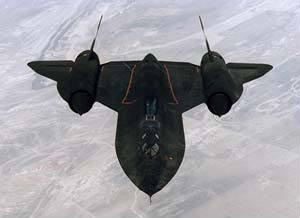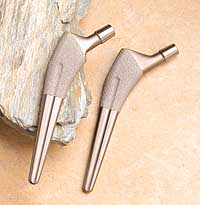Titanium Alloys and their classification: There are several titanium alloys that have been developed for use in the past four decades. These alloys include Ti-6Al-4V (an alloy of titanium, aluminum and vanadium), the most highly used alloy of titanium and Ti-4Al-4Mo-2Sn-0.5Si (an alloy of titanium, aluminum, molybdenum, tin, and silicon), which was developed later and is used less frequently.
Ti-6Al-4V Annealed Bar & Sheet - thickness <= 0.187"(data from Ref. 1)
| Temperature (°F) | Exposure (hr) |
e (%)
|
stu (ksi) | scy (ksi) | Ec (106 psi) | s0.7 (ksi) | s0.85 (ksi) | n |
| 75 | 0.5 | 10 | 130 | 126 | 16 | 127 | 124.5 | 43 |
| 400 | 0.5 | - | 105 | 96 | 14.1 | 97 | 93 | 22 |
| 600 | 0.5 | - | 99 | 84.5 | 13 | 85.5 | 82 | 22 |
| 800 | 0.5 | - | 87 | 79.4 | 11.8 | 80.5 | 77 | 21.5 |
| 1000 | 0.5 | - | 70 | 60.6 | 7.7 | 61 | 59.5 | 36 |
Aerospace Application:
 Photo courtesy of NASA Dryden |
Titanium alloys have only been used since about 1950. The most famous early use of titanium was in the Lockheed SR-71 "Blackbird" strategic reconnaissance aircraft. The Blackbird was designed to travel at three times the speed of sound at altitude of 80,000 feet. The resulting high surface temperatures eliminated aluminum and the need for low weight eliminated steel from consideration. Titanium emerged as an alternative to other metal alloys, one that would remain stiff, retain its strength, and avoid creeping at elevated temperatures. Titanium has also been found to have superb corrosion and fatigue resistance. It is roughly 66 % as heavy as steel with fairly similar mechanical characteristics. Titanium is useful as a structural material up to temperatures of roughly 1000 to 1150 °F, whereas conventional aluminum alloys are only useful up to 350 °F. |
Biomedical Application:
| Although Titanium has excellent heat and corrosion resistance capabilities, it is extremely difficult to form and machine into desired shapes. Also its extreme chemical reactivity with air, combined with other factors, has caused the cost of titanium components to be very high. The only economical applications of this material currently (until more efficient techniques of working with it can be found) are in aerospace applications where weight and temperature resistance are very important, and in military applications, they provide extreme corrosion resistance and durability. Titanium is also used in biomedical applications such as prosthetics and implants (shown to the right) due to its biological inertness. |  Photo Courtesy of Encore Orthopedics, Inc. |
For more information on material properties, go to www.matweb.com.
References:
[1] Bruhn, E. F., Analysis and Design of Flight Vehicle Structures,1 972.